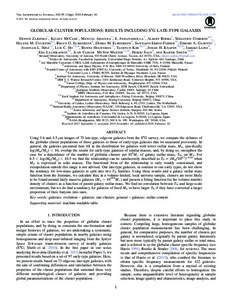GLOBULAR CLUSTER POPULATIONS: RESULTS INCLUDING S(4)G LATE-TYPE GALAXIES
Zaritsky D; McCabe K; Aravena M; Athanassoula E; Bosma A; Comeron S; Courtois HM; Elmegreen BG; Elmegreen DM; Erroz-Ferrer S; Gadotti DA; Hinz JL; Ho LC; Holwerda B; Kim T; Knapen JH; Laine J; Laurikainen E; Munoz-Mateos JC; Salo H; Sheth K
https://urn.fi/URN:NBN:fi-fe2021042714320
Tiivistelmä
Using 3.6 and 4.5 mu m images of 73 late-type, edge-on galaxies from the S(4)G survey, we compare the richness of the globular cluster populations of these galaxies to those of early-type galaxies that we measured previously. In general, the galaxies presented here fill in the distribution for galaxies with lower stellar mass, M-*, specifically log(M-*/M-circle dot) < 10, overlap the results for early-type galaxies of similar masses, and, by doing so, strengthen the case for a dependence of the number of globular clusters per 10(9)M(circle dot) of galaxy stellar mass, T-N, on M-*. For 8.5 < log(M-*/M-circle dot) < 10.5 we find the relationship can be satisfactorily described as T-N = (M-*/10(6.7))(-0.56) M-* is expressed in solar masses. The functional form of the relationship is only weakly constrained, and extrapolation outside this range is not advised. Our late-type galaxies, in contrast to our early types, do not show the tendency for low-mass galaxies to split into two T-N families. Using these results and a galaxy stellar mass function from the literature, we calculate that, in a volume-limited, local universe sample, clusters are most likely to be found around fairly massive galaxies (M-* similar to 10(10.8)M(circle dot)) and present a fitting function for the volume number density of clusters as a function of parent-galaxy stellar mass. We find no correlation between T-N and large-scale environment, but we do find a tendency for galaxies of fixed M-* to have larger T-N if they have converted a larger proportion of their baryons into stars.
Kokoelmat
- Rinnakkaistallenteet [27094]
